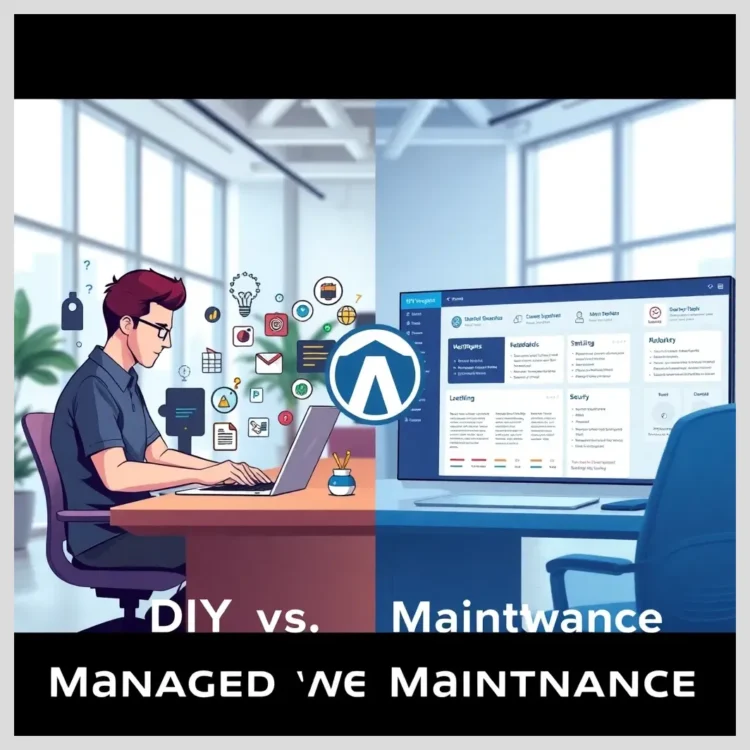In this article:
Welcome to this comprehensive guide on tracking WordPress performance metrics that matter. If you’ve built a WordPress site but wonder if it’s truly performing at its best, you’re in the right place. Website upkeep and site maintenance are crucial for keeping your site fast, secure, and engaging. This article will walk you through the essentials of WordPress performance tracking, helping you monitor your site analytics effectively without drowning in jargon or technical overload.
Here’s what you’ll learn in this article
- Understanding the core WordPress performance metrics that impact user experience and SEO
- Choosing the right tools and plugins for efficient WordPress performance tracking
- Setting clear goals to focus your tracking efforts
- A step-by-step guide to implement and monitor key metrics
- Diagnosing common performance issues and practical fixes
- Leveraging advanced insights like Core Web Vitals for optimization
- Automating and centralizing maintenance with solutions like Modular DS
- Best practices for continuous monitoring and improvement
- Real user opinions and common pitfalls to avoid
- Expert perspectives on the future of WordPress performance tracking
The Core WordPress Performance Metrics That Matter
Performance metrics are the numbers and data points that tell you how well your WordPress site is running. Knowing these helps you understand if your visitors are having a smooth experience or if something is slowing them down. Let’s break down the most important metrics you should watch.
Page Load Speed measures how fast your pages appear on a user’s screen. If your pages take too long to load, visitors get impatient and leave. Imagine waiting for a movie to start but the screen stays black for ages—that’s what slow load speed feels like online.
Uptime is the percentage of time your website is online and accessible. Downtime means your site is unreachable, which can hurt your reputation and SEO.
Bounce Rate shows the percentage of visitors who leave after viewing just one page. A high bounce rate often signals that users didn’t find what they expected or the site was too slow or confusing.
Conversion Rate tracks how many visitors complete a desired action, like making a purchase or signing up for a newsletter. This metric ties directly to your business goals.
Server Response Time and Time to First Byte (TTFB) measure how quickly your server responds to a visitor’s request. Faster responses improve user experience and SEO.
Google’s Core Web Vitals include
- Largest Contentful Paint (LCP): How long it takes for the main content to load
- Cumulative Layout Shift (CLS): Measures visual stability—pages shouldn’t jump around as they load
- Total Blocking Time (TBT): Time during which the page is unresponsive to user input
- Time to Interactive (TTI): When the page becomes fully interactive
These frontend metrics reflect real user experience and influence your Google rankings since 2021. Backend metrics like database queries and plugin performance also matter, as they affect how fast your site can serve content.
Selecting the Right Tools to Track WordPress Performance Metrics
Tracking your WordPress site’s performance is easier with the right tools. Here’s a rundown of popular options and what they offer
- Google Analytics: A free, comprehensive platform that tracks traffic, user behavior, and conversions. It’s powerful but can be complex for beginners.
- MonsterInsights: A user-friendly plugin that integrates Google Analytics into your WordPress dashboard. No coding needed, and it offers addons like Page Insights for detailed metrics.
- WP Engine Performance Insights: Available for WP Engine hosting users, this tool provides frontend metrics including Core Web Vitals with actionable suggestions.
- Query Monitor: A plugin that helps developers diagnose database queries, plugin conflicts, and PHP errors affecting performance.
- GTmetrix and Pingdom: External tools for website speed testing and performance reports.
- WP Rocket: A caching and optimization plugin that improves load times.
- Yoast SEO: Primarily an SEO plugin but also offers insights into site health and performance.
- Google Search Console: Monitors search performance, indexing issues, and site errors.
- WatchSumo: Provides uptime monitoring and alerts.
- WP Performance Score Booster: Focuses on performance enhancements through optimization techniques.
For agencies and professionals managing multiple WordPress sites, Modular DS offers a centralized, automated solution. It streamlines updates, security checks, backups, and performance monitoring across all your sites from one dashboard.
| Feature | Modular DS | MonsterInsights | WP Engine Insights | Manual Maintenance |
|---|---|---|---|---|
| Usability | Central dashboard, easy automation | Simple GA integration | Detailed frontend metrics | Time-consuming, manual checks |
| Integration | Supports multiple sites and plugins | Google Analytics only | WP Engine hosting only | Varies by skill level |
| Cost (approx.) | Starts ~$29/mo | Free + premium addons | Included with hosting | Varies, often higher |
| Scalability | Excellent for agencies | Best for single sites | Limited to WP Engine users | Depends on resources |
| Customization | High, with automation rules | Moderate, GA focused | Limited to provided metrics | Fully customizable but manual |
Setting Clear Goals to Focus Your WordPress Performance Tracking
Before diving into tracking, it’s vital to know what you want to achieve. Clear goals help you focus on the metrics that truly matter for your site’s success.
Common goals include
- Increasing traffic by attracting more visitors
- Improving user engagement to keep visitors exploring your site
- Boosting conversions such as sales, signups, or downloads
- Enhancing site speed and reliability to reduce bounce rates
- Maintaining security and uptime to protect your reputation
Each goal points to specific metrics. For example, if you want more traffic, focus on pageviews and entrances. For conversions, track form submissions and bounce rate. Setting these priorities guides your tracking setup and helps you act on the data.
Step-by-Step Guide to Track WordPress Performance Metrics That Matter
Step 1: Choose and Set Up Your Analytics Platform
Google Analytics is the go-to free tool for tracking website data. To get started, create a GA account, add your WordPress site, and install the tracking code. This code collects data about visitors, pages, and behavior.
If you want a more tailored approach, bespoke WordPress development can integrate analytics directly into your site with custom dashboards and tracking events aligned to your business goals.
Step 2: Install and Configure Tracking Plugins
Plugins like MonsterInsights make it easy to connect Google Analytics with your WordPress dashboard. After installing and activating MonsterInsights, you can enable addons such as Page Insights to get detailed metrics per page without coding.
Step 3: Define and Configure Your Tracking Goals
Set up goals in Google Analytics or your plugin to track conversions, events, and funnels. For example, track newsletter signups or product purchases as goals to measure success.
 ModularDS Analytics Integration: Comparing Google Analytics 4 vs. Matomo
ModularDS Analytics Integration: Comparing Google Analytics 4 vs. MatomoStep 4: Regularly Monitor and Analyze Your Data
Use dashboards and automated reports to spot trends, drops, or spikes in performance. Set alerts to notify you of issues like downtime or slow pages.
Step 5: Take Action Based on Insights
Use the data to optimize your site. Fix slow-loading pages by compressing images, replacing heavy plugins, or improving caching with tools like WP Rocket and WP-Optimize. Keep your site updated and secure to maintain performance.
Diagnosing Common WordPress Performance Issues Using Metrics
Slow-loading pages often result from large images, poorly coded plugins, or server issues. Bounce rate spikes can indicate confusing navigation or irrelevant content. Uptime problems might stem from hosting issues or attacks.
Query Monitor helps identify plugin conflicts and database inefficiencies. Real user monitoring (RUM) tools capture how different users experience your site, crucial for WooCommerce stores where performance can vary.
Fixes include
- Compressing and lazy-loading images
- Replacing resource-heavy plugins with lighter alternatives
- Implementing caching and CDN solutions
- Cleaning up your database regularly

Track wordpress performance metrics that matter
Leveraging Advanced Performance Insights for WordPress Site Optimization
Core Web Vitals have become critical for SEO and user experience. Tools like WP Engine’s Performance Insights provide a clear view of these frontend metrics, along with suggestions to improve.
Speed Index, TTFB, LCP, CLS, TBT, and TTI help you understand how fast and stable your site feels to users. Combining data from Google Analytics, GTmetrix, and WP Engine gives a holistic picture.
Following these insights leads to better engagement, higher rankings, and more conversions.
Automating and Centralizing WordPress Website Maintenance and Performance Tracking
Managing multiple WordPress sites can be overwhelming. Automation tools like Modular DS simplify this by centralizing updates, security checks, backups, and performance monitoring.
Modular DS offers
- A unified dashboard for all your sites
- Automated plugin and theme updates
- Security vulnerability scanning
- Performance alerts and uptime monitoring
- Scalable and customizable workflows
Many agencies and professionals have improved efficiency and reduced errors by switching to Modular DS, saving time and ensuring consistent site health.
| Aspect | Modular DS | Manual Maintenance | Other Tools |
|---|---|---|---|
| Automation | High – automatic updates & alerts | Low – manual checks | Varies |
| Centralized Dashboard | Yes | No | Partial |
| Security Monitoring | Included | Depends on tools | Varies |
| Cost | Starts ~$29/mo | Variable, often higher | Varies |
Comparison of WordPress Performance Tracking Tools
Summary of Insights
Modular DS stands out as a highly scalable and customizable solution ideal for agencies managing multiple WordPress sites, offering centralized automation and security monitoring starting at approximately $29/month. MonsterInsights provides an easy-to-use Google Analytics integration best suited for single sites with free and premium options. WP Engine Insights delivers detailed frontend metrics but is limited to WP Engine hosting users. Manual maintenance requires significant time and expertise, with variable costs and customization depending on resources. Choosing the right tool depends on your site’s scale, budget, and need for automation.
Best Practices for Continuous WordPress Performance Monitoring and Improvement
Continuous monitoring is key to keeping your WordPress site healthy. Schedule regular audits to check speed, uptime, and security. Always keep WordPress core, themes, and plugins up-to-date to avoid vulnerabilities.
Monitor user behavior to understand what content works and where visitors drop off. Use feedback loops to refine your goals and tracking setup. Engage with communities like Reddit and expert blogs to stay updated on best practices and troubleshooting tips.
Real User Opinions and Experiences on Tracking WordPress Performance Metrics
Users often praise MonsterInsights for ease of use but note it can be limited without advanced GA knowledge. WP Engine’s Performance Insights is valued for detailed frontend metrics but is exclusive to WP Engine hosting.
Modular DS receives positive feedback for saving time and centralizing management, especially for agencies handling many sites. Some users mention the learning curve but appreciate the automation benefits.
“Switching to Modular DS cut our maintenance time in half and gave us peace of mind with automated security checks.” – Agency Owner, USA
Common complaints include plugin conflicts and data overload without clear goals. Users recommend focusing on actionable metrics and avoiding too many plugins that slow down the site.
 Guide to Monitoring WordPress User Behavior Across Multiple Sites
Guide to Monitoring WordPress User Behavior Across Multiple Sites
Track wordpress performance metrics that matter
Common Mistakes to Avoid When Tracking WordPress Performance Metrics
- Ignoring key metrics or tracking irrelevant data that doesn’t align with goals
- Failing to set clear, measurable goals before starting tracking
- Installing too many plugins, causing site slowdowns and conflicts
- Neglecting regular updates and security monitoring
- Misinterpreting data without context or expert guidance
- Not leveraging automation tools, leading to inefficient maintenance
Essential Tips for Tracking and Optimizing WordPress Performance Metrics
Understand Core Performance Metrics
- Monitor Page Load Speed to reduce visitor drop-off.
- Track Uptime to ensure your site is always accessible.
- Analyze Bounce Rate to identify user engagement issues.
- Measure Conversion Rate to track business goals success.
- Monitor Server Response Time and Time to First Byte (TTFB) for faster loading.
Use the Right Tools
- Google Analytics for comprehensive traffic and behavior data.
- MonsterInsights plugin for easy GA integration without coding.
- WP Engine Performance Insights for detailed frontend metrics.
- Query Monitor to diagnose plugin conflicts and database issues.
- Modular DS for automated, centralized multi-site management.
Set Clear Goals & Act
- Define goals like increasing traffic, engagement, or conversions.
- Focus tracking on metrics aligned with your priorities.
- Regularly analyze data and adjust strategies accordingly.
- Take action: optimize images, replace heavy plugins, and improve caching.
Avoid Common Mistakes
- Don’t track irrelevant metrics that don’t support your goals.
- Avoid installing too many plugins to prevent slowdowns and conflicts.
- Never neglect regular updates and security monitoring.
- Don’t misinterpret data without context or expert advice.
Leverage Automation & Advanced Insights
- Use Core Web Vitals (LCP, CLS, TBT, TTI) to optimize user experience and SEO.
- Combine data from Google Analytics, GTmetrix, and WP Engine for a full picture.
- Automate maintenance with Modular DS to save time and reduce errors.
- Centralize updates, security scans, and performance alerts for multiple sites.
Expert Opinion: The Future of WordPress Performance Tracking and Website Maintenance
AI and machine learning are transforming how we track and optimize WordPress performance. Real user monitoring will become more personalized, capturing nuanced user behavior without server overload.
Automation platforms like Modular DS will grow in importance, offering scalable, centralized management for agencies and professionals. Bespoke WordPress development remains valuable for custom tracking and integration tailored to unique business needs.
Maintaining a reliable, efficient, user-friendly, secure, responsive, optimized, scalable, customizable, and fast-loading WordPress site requires a blend of smart tools, clear goals, and continuous care.
Summary: Key Takeaways for Tracking WordPress Performance Metrics That Matter
- Focus on core metrics like page load speed, uptime, bounce rate, conversion rate, and Core Web Vitals
- Use tools like Google Analytics, MonsterInsights, WP Engine Insights, and Modular DS for comprehensive tracking
- Set clear goals to guide which metrics to prioritize and how to act on them
- Regularly monitor, analyze, and optimize your WordPress site for ongoing improvements
- Consider automation and centralized solutions like Modular DS to save time and enhance site management
Start tracking your WordPress performance metrics today to ensure your website stays fast, secure, and user-friendly, driving growth and success for your business.
References and Further Reading
Frequently Asked Questions
What are the most important WordPress performance metrics to track?
Focus on page load speed, uptime, bounce rate, conversion rate, server response time, and Core Web Vitals like LCP, CLS, TBT, and TTI.
How can I track WordPress performance without technical skills?
Use user-friendly plugins like MonsterInsights that integrate Google Analytics into your dashboard, or consider automated platforms like Modular DS.
What tools provide the best insights for WordPress site optimization?
Google Analytics combined with MonsterInsights, WP Engine Performance Insights, GTmetrix, and Modular DS offer comprehensive tracking and optimization capabilities.
How often should I monitor and update my WordPress site?
Regular monitoring should be weekly or monthly, with updates applied promptly to WordPress core, themes, and plugins to maintain security and performance.
Can I automate WordPress maintenance and performance tracking?
Yes, tools like Modular DS automate updates, security scans, backups, and performance alerts, saving time and reducing errors.
How does Modular DS help agencies manage multiple WordPress sites?
Modular DS centralizes management with a single dashboard, automates routine tasks, monitors performance, and enhances security across all sites.
What is the impact of slow page load times on user behavior and SEO?
Slow load times increase bounce rates, reduce conversions, and negatively affect Google rankings, as users expect fast, responsive sites.
What do you think about tracking WordPress performance metrics? Have you tried any tools or strategies that worked well or didn’t? How would you like to improve your site’s performance? Share your thoughts or questions in the comments below!


















